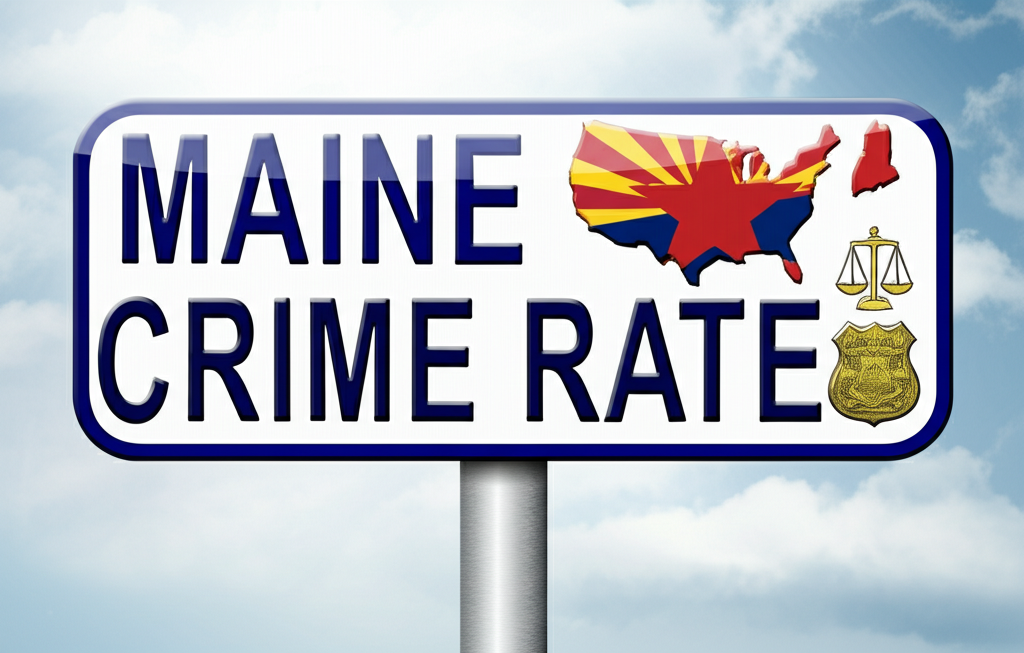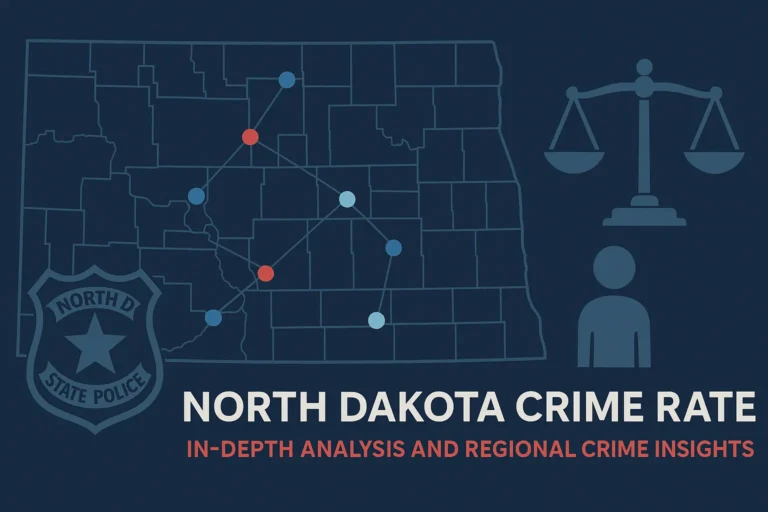Maine Crime Rate: Statistics, Trends, and Safety Insights
When you think of Maine, images of serene coastlines and charming, tranquil towns probably come to mind—but how safe is this picturesque state really? Though Maine is widely recognized for its lower-than-average crime rates, residents and visitors alike benefit from understanding its nuanced public safety profile. While violent crimes, like assault and robbery, remain notably rare compared to national figures, property crimes such as theft and burglary account for the majority of reported incidents.

In this article, we’ll provide an in-depth look at Maine’s latest crime statistics, explore emerging trends, and offer insights into the safest communities. We’ll analyze the unique factors influencing crime rates in Maine, discuss how various communities tackle safety issues, and highlight effective local strategies for crime prevention.
Join us as we uncover the realities behind Maine’s reputation for safety, helping you make informed decisions whether you’re visiting, relocating, or simply aiming to better understand this beautiful state.
Overall Crime Rate in Maine
Maine’s crime rate remains lower than the national average, making it one of the safer states in the U.S. In 2023, a total of 17,070 crimes were reported, with violent crime accounting for 1,430 incidents and property crime making up the majority at 15,640 cases. These statistics highlight key trends in safety across the state.

Breaking it down further, the violent crime rate stands at 1.02 per 1,000 residents, while property crimes occur at a rate of 11.21 per 1,000. Compared to national figures, Maine’s numbers are significantly lower, reinforcing its reputation for public safety. However, understanding where and how these crimes occur helps residents stay vigilant.
- Total crimes reported: 17,070
- Violent crimes: 1,430
- Property crimes: 15,640
Violent Crime Statistics
When we examining violence in Maine, the state shows promising trends compared to national figures. With a violent crime rate of just 1.02 incidents per 1,000 residents, Maine experiences significantly less aggression than most other states. According to FBI data, only 1,430 violent crimes were reported in 2023 across the entire state.
Law enforcement agencies categorize violent crimes into four main types: murder, rape, robbery, and assault. In Maine, assault cases make up the majority at 784 incidents, followed by 423 reported rapes. While these numbers might seem concerning, the risk remains relatively low – residents have just a 1 in 976 chance of becoming victims.
The criminal justice system plays a crucial role in maintaining these positive statistics. Maine’s approach combines prevention programs with effective policing strategies, helping keep violent crime well below the national median of 4.0 incidents per 1,000 people.
- Maine’s violent crime rate is lower than the national median
- Chances of becoming a victim: 1 in 976
| Violent Crime Type | Incidents (2023) | Rate per 1,000 |
|---|---|---|
| Murder | 60 | 0.04 |
| Rape | 423 | 0.30 |
| Robbery | 163 | 0.12 |
| Assault | 784 | 0.56 |
Property Crime Statistics
While Maine enjoys relatively low crime rates overall, property crimes make up the majority of reported incidents across the state. In 2023, authorities recorded 15,640 cases, with simple theft accounting for over 80% of these offenses. The good news? Maine’s property crime rate of 11.21 per 1,000 residents remains well below the national average.

Breaking down the numbers, burglary represents about 10% of property crimes, while motor vehicle thefts make up roughly 7%. These statistics suggest that while public security remains strong in Maine, residents should still take precautions with their belongings. The chance of experiencing property crime stands at 1 in 89 – significantly better than many states, but still warranting awareness.
- Maine’s property crime rate is lower than the national median
- Chances of becoming a victim: 1 in 89
| Property Crime Type | Incidents (2023) | Rate per 1,000 |
|---|---|---|
| Burglary | 1,538 | 1.10 |
| Theft | 13,000 | 9.31 |
| Motor Vehicle Theft | 1,102 | 0.79 |
Crime Density in Maine
Looking at crime density reveals one of Maine’s strongest safety advantages. The state records just 2 crimes per square mile, dramatically lower than the national median of 26.5. This sparse distribution means residents typically encounter fewer criminal incidents in their daily lives compared to most Americans.
Analyzing statistical data by location shows crime concentrates around geometric centers of population. Urban areas like Portland see higher density, while vast rural regions remain exceptionally safe. This pattern explains why Maine’s safest communities tend to be smaller towns away from population hubs.
The low density doesn’t just reflect fewer crimes – it also results from Maine’s large geographic size relative to its population. With abundant open space between communities, criminal activity becomes naturally dispersed across the landscape.
| Location | Crimes per Square Mile |
|---|---|
| Maine | 2 |
| National Median | 26.5 |
Top 10 Safest Cities in Maine
Maine’s commitment to public safety shines brightest in its small towns and rural communities. The state’s safest cities consistently demonstrate how effective social policy and community engagement can create secure environments for residents. These towns combine low crime rates with strong neighborhood connections, proving safety isn’t just about policing but about building cohesive communities.
From coastal villages to inland towns, these safe havens share common traits: active neighborhood watch programs, engaged local governments, and residents who look out for one another. Many benefit from Maine’s natural geography too – their smaller populations and relative isolation from urban centers naturally limit criminal opportunities.
| Rank | City/Town |
|---|---|
| 1 | Winterport |
| 2 | Richmond |
| 3 | Otis – Dedham |
| 4 | Gouldsboro – Winter Harbor |
| 5 | St. Agatha – Frenchville |
| 6 | Palermo – Freedom |
| 7 | Camden |
| 8 | Liberty – Montville |
| 9 | Woodland – Washburn |
| 10 | Eastport |
Popular Cities and Their Crime Rates
Maine’s popular cities show how demographics and urban development influence crime patterns. While generally safer than national averages, these population centers account for most reported incidents statewide. Portland, the largest city, sees higher property crime rates than rural areas, while still maintaining relatively low violent crime numbers.

According to Maine Department of Public Safety, public services and policing strategies vary significantly between these urban areas. Bangor’s revitalized downtown has helped reduce crime, while Lewiston’s industrial heritage creates different safety challenges. Each city’s unique character affects its crime profile.
Augusta, as the state capital, benefits from strong law enforcement presence, whereas Auburn’s proximity to Lewiston creates an interesting crime dynamic between the twin cities. These urban centers demonstrate how Maine balances its reputation for safety with the realities of population density.
| City | Violent Crime Rate | Property Crime Rate |
|---|---|---|
| Portland | 1.45 | 15.32 |
| Bangor | 1.12 | 12.87 |
| Lewiston | 1.78 | 14.95 |
| Augusta | 0.95 | 10.43 |
| Auburn | 1.23 | 13.56 |
Crime Data Methodology
Understanding how crime data gets collected helps interpret the numbers accurately. The methodology behind Maine’s crime statistics involves comprehensive nationwide reporting from over 18,000 law enforcement agencies. This system ensures the official statistics reflect actual conditions rather than just reported incidents.
Through careful statistical analysis, researchers account for reporting inconsistencies across jurisdictions. The FBI processes this information annually, releasing updated figures each October. Their approach combines raw crime reports with sophisticated modeling techniques to create accurate, comparable data.
By analyzing 9.4 million reported crimes nationwide, including 2 million precise location points, statisticians can adjust for underreporting and missing data. This rigorous process makes Maine’s crime statistics among the most reliable available for assessing public safety trends.
| Data Component | Detail |
|---|---|
| Source | 18,000 local law enforcement agencies |
| Latest Data | 2023 calendar year |
| Release Schedule | Annually (October) |
| Geocoded Points | 2 million locations |
Key Insights on Maine’s Crime Trends
Recent analysis of Maine’s crime data reveals several important trends worth noting. The state continues to maintain its reputation as one of America’s safest places, with both violent and property crime rates well below national averages. Social research suggests this stems from multiple factors including community cohesion and effective policing strategies.

Looking deeper into the patterns, rural areas consistently show better safety records than urban centers. This aligns with national findings that population density often correlates with higher crime rates. However, even Maine’s largest cities remain relatively safe compared to similar-sized communities elsewhere in the country.
The data also shows seasonal variations, with property crimes typically peaking during summer months when tourist populations swell. This predictable pattern allows law enforcement to allocate resources more effectively during high-risk periods.
- Maine has significantly lower crime rates than the national average
- Low crime density indicates safer rural areas
| Key Insight | Implication |
|---|---|
| Below average crime rates | Safer than most states |
| 2 crimes per square mile | Low crime density statewide |
| Rural safety advantage | Small towns safest |
| Seasonal property crime spikes | Summer requires extra vigilance |
Conclusion
In summary, Maine’s crime statistics and trends highlight the state’s commitment to public safety and the effectiveness of its criminal justice system. Despite facing challenges common to society in the United States, such as property crimes and social issues, Maine stands out for its lower than average crime rates.
The role of law enforcement agencies, including the Maine State Police, and the implementation of social policies contribute significantly to this achievement. The analysis of statistical data sets reveals that while urban areas experience higher crime density, the state’s rural communities benefit from Maine’s natural geography and strong community bonds.
Looking ahead, continued focus on emergency management, public policy, and social research will be key to addressing potential hazards and ensuring the safety and well-being of Maine’s population. The state’s approach to crime prevention and response serves as a model for balancing public security with the preservation of quality of life.





